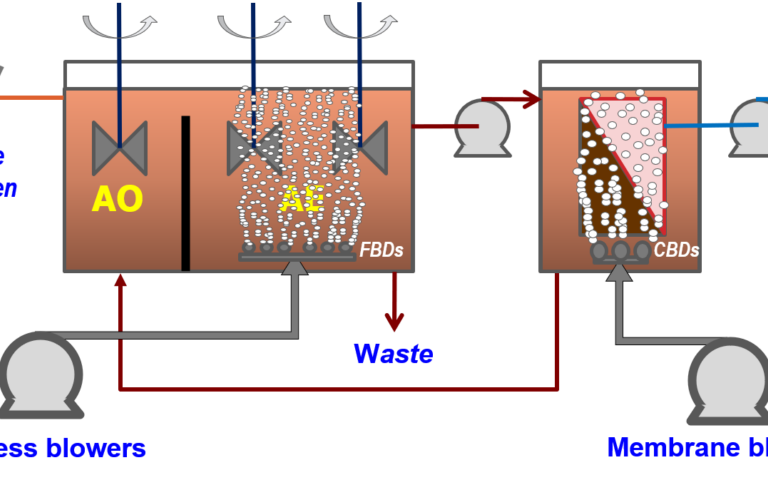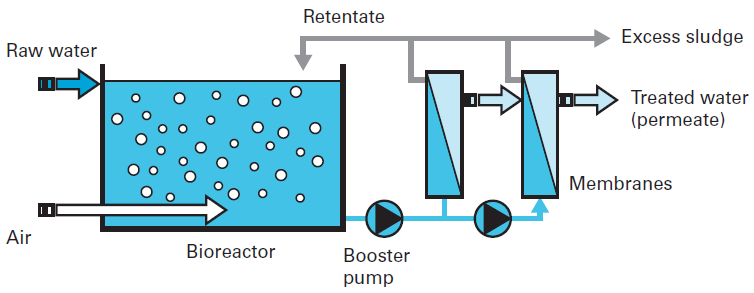The Role of Membrane Bioreactor in Achieving Higher Effluent Quality Standards
The Role of Membrane Bioreactor in Achieving Higher Effluent Quality Standards
Blog Article
Just How Membrane Bioreactors Are Reinventing Water Filtration Equipments
The introduction of membrane bioreactors (MBRs) represents a significant improvement in the field of water filtration, merging biological treatment processes with advanced membrane purification modern technologies. As worldwide water scarcity intensifies, the function of MBRs in promoting potable water reuse and sustainable water administration ends up being significantly crucial.
Overview of Membrane Layer Bioreactors
Membrane bioreactors (MBRs) stand for a substantial advancement in water filtration innovation, as they integrate biological treatment procedures with membrane layer filtration. This integration boosts the efficiency of wastewater therapy by using bacteria to deteriorate natural pollutants while concurrently using semi-permeable membranes to different cured water from suspended microorganisms and solids.
The MBR system normally includes an organic reactor where the microbial population metabolizes contaminants, followed by a membrane layer filtration system that keeps biomass and enables only tidy water to travel through. This twin capability causes higher effluent quality contrasted to standard therapy approaches. MBRs can be run in both set and continual flow modes, using flexibility in style and application.
Furthermore, MBRs are characterized by their small impact, making them ideal for metropolitan settings with room constraints. Membrane Bioreactor. They likewise enable the healing of water for reuse, therefore adding to water sustainability efforts. While MBR modern technology has obtained popularity in industrial and municipal applications, its operational complexities and energy demands demand cautious consideration during implementation. Overall, MBRs go to the forefront of boosting water treatment performance and quality, showcasing the possibility for ingenious services in ecological administration.
Advantages of MBR Innovation
The assimilation of organic therapy with membrane filtration uses countless benefits for water filtration processes. One of the primary advantages of Membrane Bioreactor (MBR) technology is its ability to effectively get rid of both not natural and natural contaminants, resulting in high-quality effluent. The membranes work as a physical obstacle, protecting against suspended solids and virus from going through, which improves the overall security and reliability of treated water.
In addition, MBR systems need a smaller sized impact contrasted to conventional treatment approaches, permitting for much more effective room utilization. This portable layout is specifically useful in metropolitan setups where land is restricted. MBRs likewise demonstrate functional adaptability, suiting differing influent qualities and flow rates without substantial performance degradation.
Furthermore, the process provides enhanced nutrient elimination capacities, particularly for nitrogen and phosphorus, which are crucial for preventing eutrophication in getting waters. The lowered sludge production related to MBR technology likewise equates to reduce disposal costs, making it an economical service in the lengthy run - Membrane Bioreactor. On the whole, the advantages of MBR innovation setting it as a leading choice for lasting and ingenious water filtration systems, resolving both ecological and financial concerns
Applications in Water Filtration
Applications of Membrane Layer Bioreactor (MBR) modern technology in water filtration are impactful and varied, resolving different treatment requires throughout multiple sectors. MBRs efficiently combine biological treatment processes with membrane layer filtration, making them perfect for community wastewater therapy, commercial effluent administration, and also safe and clean water reuse initiatives.
In community settings, MBRs are increasingly used to boost the high quality of treated wastewater, enabling conformity with strict discharge laws and promoting the recycling of water for irrigation and non-potable uses. Their portable style likewise makes them appropriate for urban environments where room is limited.
Industrially, MBR technology is utilized to deal with process water and wastewater, especially in markets such as food and beverage, pharmaceuticals, and fabrics. By properly removing contaminants and put on hold solids, MBRs assist industries decrease ecological influences while recouping useful sources from wastewater streams.
Moreover, see here MBRs are getting traction in decentralized water therapy applications, where small systems can be released in remote locations or developing regions. This adaptability enables neighborhoods to accomplish sustainable water administration remedies, improving access to tidy water while decreasing dependence on standard therapy methods.
Study and Success Stories

In an additional example, a textile manufacturing facility in Bangladesh took on MBR modern technology to resolve its wastewater obstacles. The system reduced chemical oxygen need (COD) levels from 1,200 mg/L to less than 100 mg/L, thus meeting regulative standards and significantly decreasing environmental influence.
The College of Cape Town's MBR installation has proven reliable in treating greywater for non-potable reuse on campus. This job not just conserves drinkable water yet likewise functions as an instructional model for lasting techniques.
Moreover, a fish and shellfish processing plant in Norway made use of MBR modern technology to deal with effluents having high levels of natural issue, attaining over 90% pollutant elimination. These situation studies highlight MBR innovation's convenience and its important duty in improving water top quality across varied applications.
Future of Water Therapy Solutions
As international water deficiency and pollution obstacles magnify, cutting-edge water treatment remedies are coming to be increasingly important to make sure lasting accessibility to clean water. The see here future of water therapy exists in the assimilation of innovative modern technologies that boost the effectiveness and efficiency of purification procedures. Membrane bioreactors (MBRs) go to the forefront of this advancement, incorporating organic therapy with membrane layer filtering to create premium effluent ideal for numerous applications.

Arising trends such as source healing from wastewater, including nutrients and power, will further change therapy facilities right into eco-friendly centers. Advancements in nanotechnology and membrane layer materials promise enhanced performance and long life of filtering systems.

Final Thought
Their duty in drinkable water reuse and sustainable water monitoring highlights their value in addressing international water shortage challenges. Proceeded research and growth will additionally improve the effectiveness and fostering of MBR technology, ensuring a resilient future for water therapy solutions.
The appearance of membrane layer bioreactors (MBRs) stands for a significant innovation in the field of water purification, combining organic therapy procedures with innovative membrane filtration technologies. As worldwide water scarcity heightens, the function of MBRs in helping with potable water reuse and sustainable water administration ends up being progressively important. They likewise enable the healing of water for reuse, thus adding to water sustainability efforts.As international water scarcity and air pollution obstacles escalate, cutting-edge water treatment solutions are ending up being significantly vital to make sure lasting access to tidy water. Their duty in potable water reuse and sustainable water management highlights their significance in attending to global water deficiency difficulties.
Report this page